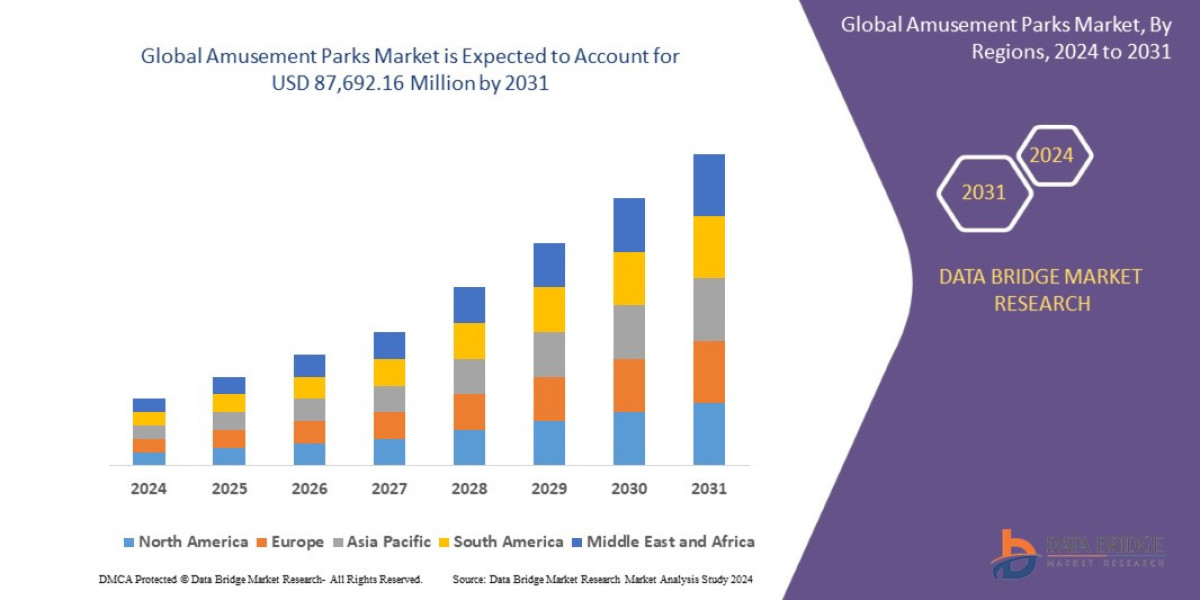Executive Summary
- The global amusement parks market was valued at USD 66.20 billion in 2024 and is expected to reach USD 91.29 billion by 2032
- During the forecast period of 2025 to 2032 the market is likely to grow at a CAGR of 4.10%.
Market Overview
The Amusement Parks Market encompasses a wide range of paid recreational facilities, including theme parks, water parks, family entertainment centers (FECs), and destination resorts that offer themed rides, attractions, shows, and retail and dining experiences. The market is highly cyclical, sensitive to global economic conditions, and intensely focused on consumer sentiment and safety.
The market can be segmented in various ways:
By Type of Park:
Theme Parks: The largest and most visible segment, characterized by overarching themes, intellectual property (IP) integration (e.g., movie franchises), and high-capacity, large-scale rides.
Water Parks: Focused on aquatic attractions, including slides, wave pools, and interactive water play areas. This segment is highly seasonal but offers lower construction costs than theme parks.
Amusement/Adventure Parks: Generally feature classic rides (ferris wheels, roller coasters) without a unified theme, often focusing on thrill and adrenaline.
By Revenue Stream:
Admissions: The primary source of revenue, including ticket sales, annual passes, and express passes.
In-Park Spending (Ancillary Revenue): This includes spending on merchandise, food & beverage (F&B), and gaming/arcade experiences, which often account for a significant portion of total revenue.
By Visitor Type:
Domestic: Visitors residing in the local area or country, providing stable baseline traffic.
International: Tourists driven by the destination status of major parks, sensitive to exchange rates and travel restrictions.
The current market dynamic is characterized by the “experience economy”, where consumers prioritize memorable activities over physical products. Key market drivers include the rapid expansion of the middle class in Asia, increased leisure time, and the continuous need for large operators to invest billions in new IP-based attractions to maintain freshness and drive repeat visits. Safety and cleanliness standards, particularly post-pandemic, have become non-negotiable consumer expectations.
Market Size & Forecast
- The global amusement parks market was valued at USD 66.20 billion in 2024 and is expected to reach USD 91.29 billion by 2032
- During the forecast period of 2025 to 2032 the market is likely to grow at a CAGR of 4.10%.
- For More Information https://www.databridgemarketresearch.com/reports/global-amusement-parks-market
Key Trends & Innovations
The Amusement Parks Market is highly reliant on innovation, constantly seeking new ways to thrill, entertain, and manage the guest experience more efficiently.
Immersive IP Integration: Attractions are moving beyond simple ride mechanics to create deep, narrative-driven immersion. This involves seamless blending of physical sets, special effects, and projection mapping, making guests feel like they are truly inside a movie or story world (e.g., Star Wars: Galaxy's Edge).
Virtual and Augmented Reality (VR/AR):
VR Integration: Used in roller coasters and dark rides to layer digital visuals over physical motion, offering infinite possibilities for theme changes without changing the track.
AR Experiences: Utilized through park apps to gamify the park experience, adding interactive elements, scavenger hunts, and digital characters that appear in the real world.
Dynamic Pricing and Yield Management: Sophisticated data analytics and AI are being used to implement dynamic pricing models that adjust ticket costs based on real-time factors like anticipated demand, weather forecasts, and historical attendance data, maximizing revenue yield.
Sustainability Focus: Operators are increasingly investing in sustainability measures, including installing solar power, implementing advanced waste management programs, and using recycled water. This aligns with rising consumer expectations for environmentally conscious businesses.
Gastro-tourism and Premium F&B: Food and beverage offerings are no longer just generic concessions. Parks are developing highly themed, high-quality, and often fine-dining experiences that are integral to the overall immersion and serve as a significant driver of ancillary revenue.
Competitive Landscape
The global Amusement Parks Market is intensely competitive and characterized by a clear hierarchy. It is dominated by a few global mega-operators that rely on IP, massive capital expenditure, and international brand recognition, alongside numerous strong regional players.
Major Players and Competitive Strategies:
The Walt Disney Company (Disney Parks, Experiences and Products): The global market leader, leveraging the industry's strongest IP portfolio (Marvel, Star Wars, Pixar). Its strategy focuses on creating multi-day destination resort experiences, maximizing per-capita spending, and maintaining premium pricing through unparalleled brand loyalty.
Universal Parks & Resorts (NBCUniversal): A dominant competitor that utilizes strong film IP (Harry Potter, Jurassic Park). Its strategy focuses on rapid innovation, technological superiority in attractions, and strategic partnerships (like with Nintendo) to compete directly with Disney's IP strength.
Merlin Entertainments (LEGOLAND, Alton Towers): The largest European-based operator, focused on a diversified portfolio of brands and park sizes, including smaller, regional attractions that cater to local and short-stay tourism.
Six Flags Entertainment & Cedar Fair: Leading North American regional operators, focused heavily on thrill rides, high-capacity operations, and regional season pass sales.
Regional Players (e.g., Chimelong Group in China, Fantawild in China): These players are rapidly gaining ground by targeting the massive domestic Asian market with large, high-quality parks often incorporating local cultural themes.
The core competitive differentiation is a blend of exclusive IP control, the scale of capital investment in new attractions, and technological efficiency in managing guest flow and spending.
Regional Insights
The Amusement Parks Market exhibits varied growth rates and maturity levels across different global regions.
Asia-Pacific (APAC): Currently the fastest-growing and largest regional market in terms of visitors and new park development. The burgeoning middle class in China, India, and Southeast Asia, combined with government-backed tourism initiatives, has made this the central focus for all major global operators. Expansion and localization of content are key strategies here.
North America: A mature and highly concentrated market, dominated by the mega-resorts in Florida and California. Growth is driven primarily by raising ticket prices, maximizing ancillary spending, and replacing/upgrading existing attractions rather than building entirely new parks.
Europe: A mature but fragmented market, characterized by strong regional chains (Merlin, Europa-Park) and a mix of destination parks and small family-run amusement parks. The market is highly seasonal and driven by regional tourism and proximity to urban centers.
Middle East & Africa (MEA) / Latin America (LATAM): These are emerging markets with high-potential growth. MEA, particularly the UAE and Saudi Arabia, is seeing massive, state-backed investment in large-scale IP-driven theme parks and entertainment resorts as part of economic diversification strategies. LATAM growth is more modest but steady, driven by urbanization and rising domestic tourism.
Challenges & Risks
Despite the buoyant outlook, the Amusement Parks Market faces several significant operational and external challenges.
High Barrier to Entry and Capital Intensity: New park development requires billions of dollars in initial investment, making it accessible only to major corporations or state-backed funds. The continuous need for capital to refresh attractions is immense.
Safety and Liability: The industry faces constant scrutiny regarding ride safety, public health, and security. Any major accident or health scare can have a devastating, immediate impact on brand trust and attendance.
Seasonal and Economic Sensitivity: Weather conditions significantly impact attendance for many parks, and consumer spending on leisure is highly susceptible to economic downturns, inflation, and unemployment rates.
Talent Management and Labor Costs: Maintaining a large, specialized, and often seasonal workforce (especially for service-oriented roles) is a perpetual challenge, often compounded by rising labor costs and union pressures.
Opportunities & Strategic Recommendations
The challenges in the market are fueling innovation, creating substantial opportunities for stakeholders who are prepared to invest strategically and adapt to technological change.
For Major Operators (Manufacturers):
Hyper-Personalization: Leverage data from park apps and wearable technology to offer truly personalized experiences (e.g., customized attraction interactions, targeted F&B promotions), driving higher satisfaction and ancillary spend.
Maximize Non-Peak Revenue: Invest in conventions, corporate events, and non-seasonal offerings (e.g., premium dining, highly themed lodging) to stabilize revenue throughout the year.
Acquire and Develop Niche IP: Beyond mainstream film IP, acquire or license smaller, beloved intellectual properties to develop unique, highly-themed attractions that target specific fan bases.
For Technology and Startup Investors:
Queue Management Software: Invest in sophisticated virtual queuing, demand forecasting, and ride capacity optimization software that is essential for mitigating guest frustration and maximizing throughput.
Augmented Reality (AR) Experiences: Develop scalable AR platforms that can be easily integrated into existing parks for seasonal content, gamification, and digital collectibles, offering cheap, refreshing content without major construction.
For Regional Parks:
Focus on Localized IP and Value: Compete not on IP scale, but on value, speed of access, and unique, regionally relevant attractions. Target the local family market with strong season pass incentives.
Sustainability Certification: Seek visible third-party certification for sustainability practices to attract the growing segment of environmentally conscious tourists.
Browse More Reports:
Global Sezary Syndrome Treatment Market
Global Dispensing Caps Market
North America Rotomolding Market
Global Diabetic Neuropathy Market
Global Nano GPS (Global Positioning System) Chip Market
Global Data Roaming Market
Global Citric Acid Market
Global Wipes Market
Global Aquatic Feed Enzymes Market
Global Waste Management Market
Global Mist Eliminators Market
Global Asphalt Additive Market
Global Regulatory Technology (Regtech) Market
Europe Infection Surveillance Solution Systems Market
Global Vehicle Tracking System Market
U.S. Health, Safety, and Environment (HSE) Training Services Market
North America Dental Practice Management Software Market
Global Sludge Treatment Chemicals Market
Global Tinted Glass Market
Global Network Security Market
Global Front and Rear Air-Conditioning (AC) Thermal Systems Market
Global Polymeric Biomaterial Market
Global Household Cleaning Products Market
Europe Electrosurgery Market
Global Bilateral Cystoid Macular Edema Market
Global Edge Banding Materials Market
Global Speciality Malts Market
Middle East and Africa Weight Loss and Obesity Management Market
Middle East and Africa Hydrographic Survey Equipment Market
North America Food Bags Market
Global Surface Roughness Measurement (SRM) Market
About Data Bridge Market Research:
An absolute way to forecast what the future holds is to comprehend the trend today!
Data Bridge Market Research set forth itself as an unconventional and neoteric market research and consulting firm with an unparalleled level of resilience and integrated approaches. We are determined to unearth the best market opportunities and foster efficient information for your business to thrive in the market. Data Bridge endeavors to provide appropriate solutions to the complex business challenges and initiates an effortless decision-making process. Data Bridge is an aftermath of sheer wisdom and experience which was formulated and framed in the year 2015 in Pune.
Contact Us:
Data Bridge Market Research
US: +1 614 591 3140
UK: +44 845 154 9652
APAC : +653 1251 975
Email:- corporatesales@databridgemarketresearch.com








